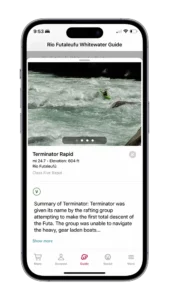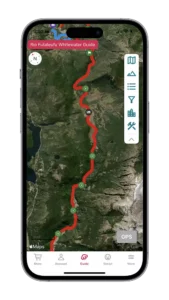About Terminator Rapid
Terminator was given its name by the rafting group attempting to make the first total descent of the Futa. The group was unable to navigate the heavy, gear-laden boats through the rapid and their journey was Terminated here. For class V kayakers, Terminator has endless line variations that include amazing surfing, boofs, massive holes, and fun waves. For rafts and less skilled kayakers, there are some good Class IV sneak lines and portages available as well. Terminator is long and wide with hundreds of boulders and dozens of hydraulics. The scope makes describing the specifics of lines challenging. If you question your ability to function in this type of environment, it is highly recommended to boat with someone who can show you the sneak lines and portages.
First portage option – 39.25 KM
River Right. Well upstream of Terminator you will see a tall cliff where the Futa makes a dramatic 90° left turn. This turn means you are getting close. Looking ahead you will eventually see a large rock outcrop on river left. As the river hits this outcrop and bends to the right, hug the right shore and catch a large eddy. This is a good place to regroup before approaching the entrance to Terminator Rapid. From this eddy, it is possible to portage the entire rapid with a kayak. The trail is not commonly used and less obvious than other portaging trails. There is another option to portage the meat of Terminator if you can handle some must make Class III-IV moves below.
Terminator Entrance Rapid – 39.5 KM
Class IV. Ferry all the way river left to the last eddy above the entrance to the rapid. If you want to scout, portage, or take the sneak line in Terminator, make your way down the left side of the entrance. Kayakers should stay as far left as they can. Rafters need to be in the second most left “channel” where the gaps are big enough. About 100 meters down, there is a large boulder on the left that creates a pool that can fit a few rafts and several kayaks. As you are approaching, keep thinking left, left, left. Getting pulled into the center would be full on Class V. The trail to scout or portage is up into the trees just below this large boulder.
Terminator scout and second portage option – 39.75 KM
River Left. Follow the trail until it forks. The right fork accesses a boulder with the best vantage point of the rapid. The left fork continues the portage below Terminator. The last section of the portage trail is steep as you reconnect with the water. If you start climbing again you have gone too far.
How to run Terminator Rapid (after the entrance) – 39.5 KM
Class V. A rapid this wide and complex is going to have a plethora of lines varying in difficulty. Kayakers take the center line from top to bottom with regularity. Rafts almost never. This description will focus more on the raft line and sneak line along the left. At medium and low water, there is a highly technical raft line that might be hard to recognize from shore unless someone points it out to you.
The major goal of running the left line is to keep kayaks and rafts away from the center of the river. There are massive boat flipping holes in the center with fast whitewater directly below. From the scouting pool, find the large boulder twenty meters into the center, slightly upstream. This boulder is the left edge of the first navigable channel (all the way left is too shallow at most flows). Ferry upstream of the large boulder and turn your boat to face downstream. Depending on flow, there can be a hole next to the boulder. Hit the hole straight, but be ready to immediately change your angle and start working left. Blowing your angle here can push you out into the center. Navigate through an easy rock garden, focusing more on location and angle, speed is not your friend here. Continuing left will bring you to the crux move. Reintroduce some speed as you cut below a smaller boulder on the left. There is a surprisingly powerful hole below on the right. If you cut underneath the rock perfectly, you won’t hit the hole. If you hit the hole it’s unlikely to flip you, but still packs a punch. For the final “typewriter move” square up to a lovely lateral wave and enjoy getting “type-writered” left to right. When you nail this line, it is a wonderful feeling. Issues typically arrive at the top of the crux move when boats hit that hole, lose their angle, and hit the typewriter wave sideways. At high water, the leftmost line along the shore opens up. This highwater line is more difficult than the low/medium water line described above. It involves punching through a hole to catch an eddy and solid 2 meter boof. If you swim sneaking along the left, you are likely getting pushed into the center and swimming the next kilometer.








